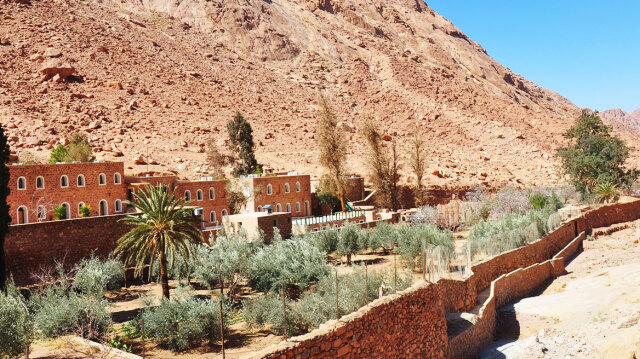What fifteen centuries of uninterrupted existence of the Holy Monastery of Sinai could not achieve, and what was resisted by countless conquerors, the Egyptian state is now attempting to accomplish through a court ruling that effectively confiscates the Monastery’s historic property and building, leading to its potential closure.
This situation involves the Holy Monastery, the only Christian site that the Prophet Muhammad himself sought to protect. His Achtiname (covenant), safeguarded in the Monastery’s library and bearing his palm imprint as a seal, grants special privileges to the Holy Monastery of Saint Catherine of Sinai.
The attempt to “evict” the Monastery from Sinai has a history spanning at least 25 years, with the Muslim Brotherhood and Egyptian nationalists targeting it due to their resentment towards the prominence and global significance of a living Orthodox Christian monument in Sinai.
Recent developments, including a court ruling that effectively strips the Monastery of all its property—encompassing the church and surrounding buildings—represent a serious affront and provocation not only to the Christian community but also to the international community at large. The Holy Monastery of Saint Catherine of Sinai is a noted site on the UNESCO World Heritage List.
This incident also raises significant concerns regarding Greek-Egyptian relations, particularly as President Sisi had, during a visit to Athens, welcomed an agreement with Prime Minister Kyriakos Mitsotakis aimed at resolving the ongoing legal issues surrounding the Monastery since 2015.
Reports indicate that by the end of 2024, following discussions at the political level with Cairo, a Greek delegation approved a settlement between Archbishop Damianos and the Egyptian state. This agreement stipulated the withdrawal of legal appeals and recognized the Monastery’s ownership rights, with an obligation to collaborate with Egypt’s Antiquities Authority for safeguarding the monuments.
This settlement was publicly endorsed in Athens by Mr. Mitsotakis and Mr. Sisi, who were awaiting the finalization process with the Egyptian Ministry of Justice’s signature. Instead, a court ruling was issued yesterday, which Cairo failed to communicate officially to Athens.
Cairo’s actions must be addressed at the highest political levels, alongside concerted efforts from UNESCO and the EU, sending a clear message that it will adversely affect bilateral relations between the two countries.
Egypt’s response will significantly impact its credibility, and Athens will draw critical conclusions about its reliance on Cairo’s assurances in the future, especially concerning other major issues in the Eastern Mediterranean. Unofficial church sources suggest that the ruling declares all Monastery property belongs to the Egyptian state, while monks are only granted the right to remain in the Monastery.
Through this approach, Egypt seeks to negate a 15-century-long history, treating the Monastery as a mere “dead” monument and overlooking its status as an essential site of global cultural heritage and active religious worship.
The initial challenge to the Monastery’s property arose in 2015 from the then-governor of South Sinai, who filed a case against Archbishop Damianos due to the Monastery’s lack of legal recognition. This case involved 31 buildings and 40 agricultural properties, including the Monastery’s facilities, gardens, guesthouses, and library.
There are serious concerns regarding the possible impact on the Monastery’s unique and invaluable library, as well as the priceless icons housed within the church, exhibition areas, and restoration workshops.
Without prompt political intervention to halt the court ruling’s implementation, the Monastery faces imminent closure and the risk of being transformed into a “tourist attraction,” while the fate of the monks remains uncertain, particularly since about ten elderly Greek monks have had their residency permits in Egypt expire without renewal.
Ask me anything
Explore related questions
















